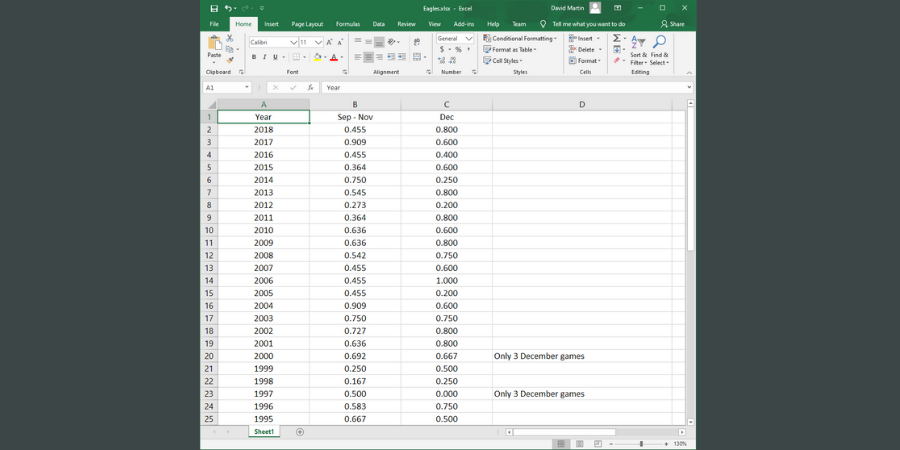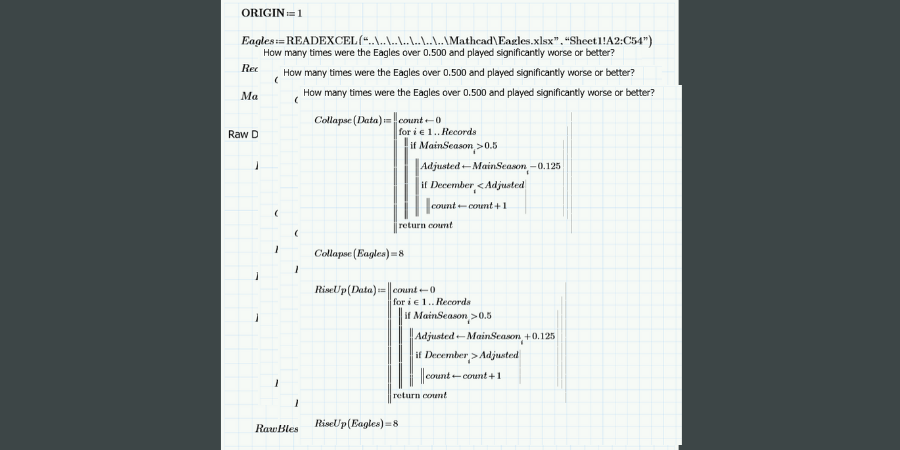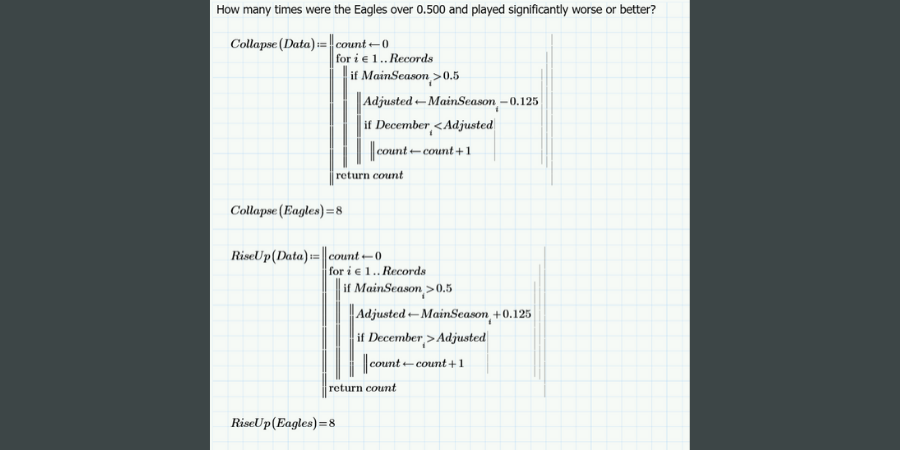I am a Philadelphia Eagles fan. I know the meaning of pain and disappointment. Growing up, I always heard that my Philadelphia Eagles had a December curse. There’s a lot of reasons why a team can break down in the fourth month of the season. It’s a grueling sport and injuries are part of the game.
I used to work for Amazon, where they say “we’re a data-driven company.” A mark of maturity is to change one’s mind, opinions, or beliefs in the light of new evidence. I decided to analyze the history of my favorite sports franchise to answer the question using data: do the Philadelphia Eagles have a December curse?
The first step was to collect 53 years of Eagles data, for their records from September through November and December, in an Excel spreadsheet:

To determine whether my Eagles have a December curse or not, I read the data into PTC Mathcad. I find it much easier to do simple analysis in PTC Mathcad than in Excel.
In PTC Mathcad, I can write a program that loops over the rows in my Excel data, compares the record of the main season to the record of December, and returns the number of cursed Decembers and number of blessed Decembers. In fact, any engineer can write such a program in PTC Mathcad without having a skillset in programming or coding.
In Excel, I could do this with a macro, but it requires more of a skillset in coding and is certainly not as transparent. Writing programs in PTC Mathcad to perform calculations that rely on logic such as for loops and while loops are easy to do.
The outputs from my PTC Mathcad programs can be seen in the image below. It turns out that the Eagles did better in December for 31 of the 53 years (58.5%), and 21 times they played worse (39.6%). (In 2003 they were 0.750 before and after December 1.)

That’s a little surprising. Already my Eagles are showing evidence that my conventional wisdom is unfounded. But I’m not interested in raw numbers; I’m interested in a curse.
I pick a delta of 0.125 as a significant difference in play for December. (That’s 2 games over a 16-game season, the difference between making the playoffs or not.) When I factor this in, it turns out that 22 times the Eagles played significantly better and only 13 times they played worse. It’s still showing that the Eagles are a December team.
But what about collapses? First, I calculate how many times the Eagles went into December with a winning record: 24, or 45.3% of the time.
How many times was their December records more than 0.125 worse than prior? Eight, or one-third of the time.

At first, I think, wow, that’s pretty bad, but then I find that eight times they went into December over 0.500 and have a record more than 0.125 better than prior. They’re just as likely to rise up as they are to collapse.
Seeing that the data contradicts my beliefs, I wanted to figure out why I held this incorrect belief. I analyzed the data up through my time in high school. In that case, the Eagles played significantly worse 6 times in December, but only 3 of those times they were over 0.500. (When the Eagles stank, they really stank.)
But during those years, the Eagles went into December with a winning record only 6 times out of 23 years (26%). They played more 0.125 better only once. They played significantly worse 3 times – or half the time they went into December with a winning record.
Therein explains how my childhood forever scarred me into thinking the Eagles had a December curse.
Some other interesting numbers:
What do I take from this? My Philadelphia Eagles don’t have a December curse – they have a December blessing. By analyzing the data, I was able to dispel a long-held incorrect belief.
In this post I used data analysis on a sport, a pastime, a hobby. Let’s look at the bigger picture. As I wrote about Bayes’s Theorem, it’s human nature to ascribe more weight to bad news than good. Data analysis with PTC Mathcad helps us make better decisions by replacing false beliefs and irrational assumptions with facts.
“Fly, Eagles, fly, on the road to victory…”
It turns out the Eagles don't have a December curse, but given that they've only won the championship once in 3 trips to the big game in 54 years, it's clear that they have a January curse. And a Seahawks curse. They lost twice to Seattle at Lincoln Financial Field this season. I live in Seattle and both Eagles games I went to, they lost - even their championship season.
'Any given Sunday, any team can beat any other team.'
Use the calculation software professional scientists and engineers use. Download your free copy of PTC Mathcad Express today. Choose the full functionality option, and you’ll get the full version of PTC Mathcad Prime for 30 days.

Dave Martin is a Creo, Windchill, and PTC Mathcad instructor and consultant. He is the author of the books “Top Down Design in Creo Parametric,” “Design Intent in Creo Parametric,” and “Configuring Creo Parametric,” all available at amazon.com. He can be reached at dmartin@creowindchill.com.
Dave currently works as the configuration manager for Elroy Air, which develops autonomous aerial vehicles for middle-mile delivery. Previous employers include Blue Origin, Amazon Prime Air, Amazon Lab126, and PTC. He holds a degree in Mechanical Engineering from MIT and is a former armor officer in the United States Army Reserves.